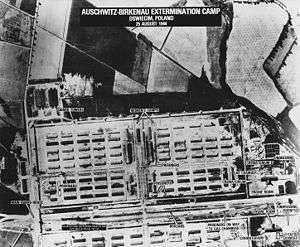Robert Jan van Pelt
Robert Jan van Pelt (born 15 August 1955) is a Dutch author, architectural historian, professor at the University of Waterloo and a Holocaust scholar. One of the world's leading experts on Auschwitz, he regularly speaks on Holocaust related topics, through which he has come to address Holocaust denial. He was an expert witness in Deborah Lipstadt's successful defence in the civil libel suit brought against her by David Irving.


Early life and career
Van Pelt was born in Haarlem. At Leiden University, van Pelt obtained an undergraduate degree in art history and classical archaeology, a graduate degree in architectural history, and a PhD in the history of ideas. While pursuing his studies, he worked as an architectural historian, involved with the restoration of Noordeinde Palace in The Hague.[1]
Career
Teaching
He joined the University of Waterloo in 1987 and has taught courses pertaining to the cultural history of the Middle Ages, the Renaissance and Enlightenment periods, the 19th century, and also participates in topics including urban history and film history.[2]
He is currently Professor of Cultural History in the university's architectural faculty.[3]
Holocaust research
Van Pelt's Holocaust studies began while he was studying the Temple of Solomon under Renaissance scholar Frances Yates as part of his doctorate.[2] He has stated that he was stunned when he first entered the Auschwitz architectural archive, commenting that the place allows one to imagine what the place looked like during the war and holds a "tactile reality" as to how the camp was built, and that here, he found his mission.[4] His pursuit of Auschwitz as a point for architectural study arose when he nominated one of the crematoria and gas chamber complexes at Auschwitz-II Birkenau to be included in the University of Virginia architecture classes canon, a decision which he says was controversial among academics there.[5] Van Pelt has also appeared in Errol Morris's Mr. Death: The Rise and Fall of Fred A. Leuchter, Jr., a documentary film about Fred Leuchter where he comments on and criticises Leuchter's methods and findings that constituted Leuchter's report for the defense of Ernst Zündel. In the film, van Pelt offers the analogy that the Nazis were the first Holocaust deniers, because through the obscure euphemisms and terminology they used in reference to their homicidal equipment, they attempted to deny to themselves what they were doing.[4]
In the successful defence of Deborah Lipstadt, van Pelt was one of the four Holocaust historians who served as expert witnesses,[6] and he defended the 770-page report[7] he produced during five days of cross-examination.[2] His involvement in the trial was included in the 2016 film Denial, in which he was played by British actor Mark Gatiss.[8]
Also in 2016, his research into the architecture of Auschwitz was presented in the exhibition Architecture as Evidence at the Venice Biennale and the Canadian Centre for Architecture.[9][10]
Writing
Van Pelt has written five books and co-authored two with Debórah Dwork. He has also contributed chapters to twenty books, and has published more than thirty articles.[6] In addition, he has served as an advisor on films and has also contributed in both the physical and dramatical reconstructions in Laurence Rees' Auschwitz: The Nazis and the 'Final Solution' television documentary.[3] He wrote the introduction to the first English-language edition of David Koker's diary.[11]
Awards
Van Pelt's awards include University of Waterloo Outstanding Professor 2005, the National Jewish Book Award (1996) for Auschwitz: 1270 to the Present, and the Spiro Kostof Award (1997) from the Society of Architectural Historians. He was a 1994-95 fellow of the John Simon Guggenheim Memorial Foundation, and was a 2002-04 fellow of the University of Waterloo's faculty of environmental studies.
References
- "Grand Valley Society of Architects - Robert Jan van Pelt of the UW school of architecture". Archived from the original on 2011-07-06. Retrieved 2008-06-02.
- Jen, Leslie. "Van Pelt, Robert Jan". The Canadian Encyclopedia. Retrieved 2008-06-02.
- "Auschwitz: Inside the Nazi State . About . Advisors". PBS. Retrieved 2008-06-02.
- Morris, Errol. "Mr. Death: Transcript". Retrieved 2008-06-02.
- Pelt, Robert Jan van (2002). The Case for Auschwitz: Evidence from the Irving Trial. Indiana University Press. p. 66. ISBN 0-253-34016-0. Retrieved 2008-06-02.
My proposal to include Crematorium 2 among the key buildings .
- "The Jewish Foundation for the Righteous:". Retrieved 2008-06-02.
- The Van Pelt Report; Electronic Edition, by Robert Jan van Pelt
- "Denial". imdb.com. IMDb. Retrieved 20 Feb 2017.
- "2016 Venice Biennale Exhibition to Examine the 2000 Irving Trial and the Architecture of the Holocaust". ArchDaily. 2016-02-22. Retrieved 2020-06-19.
- Canadian Centre for Architecture (CCA). "Architecture as Evidence". www.cca.qc.ca. Retrieved 2020-06-19.
- Jordan Michael Smith (28 March 2012). "Life Inside the Camps". Tablet Magazine. Retrieved 31 March 2012.